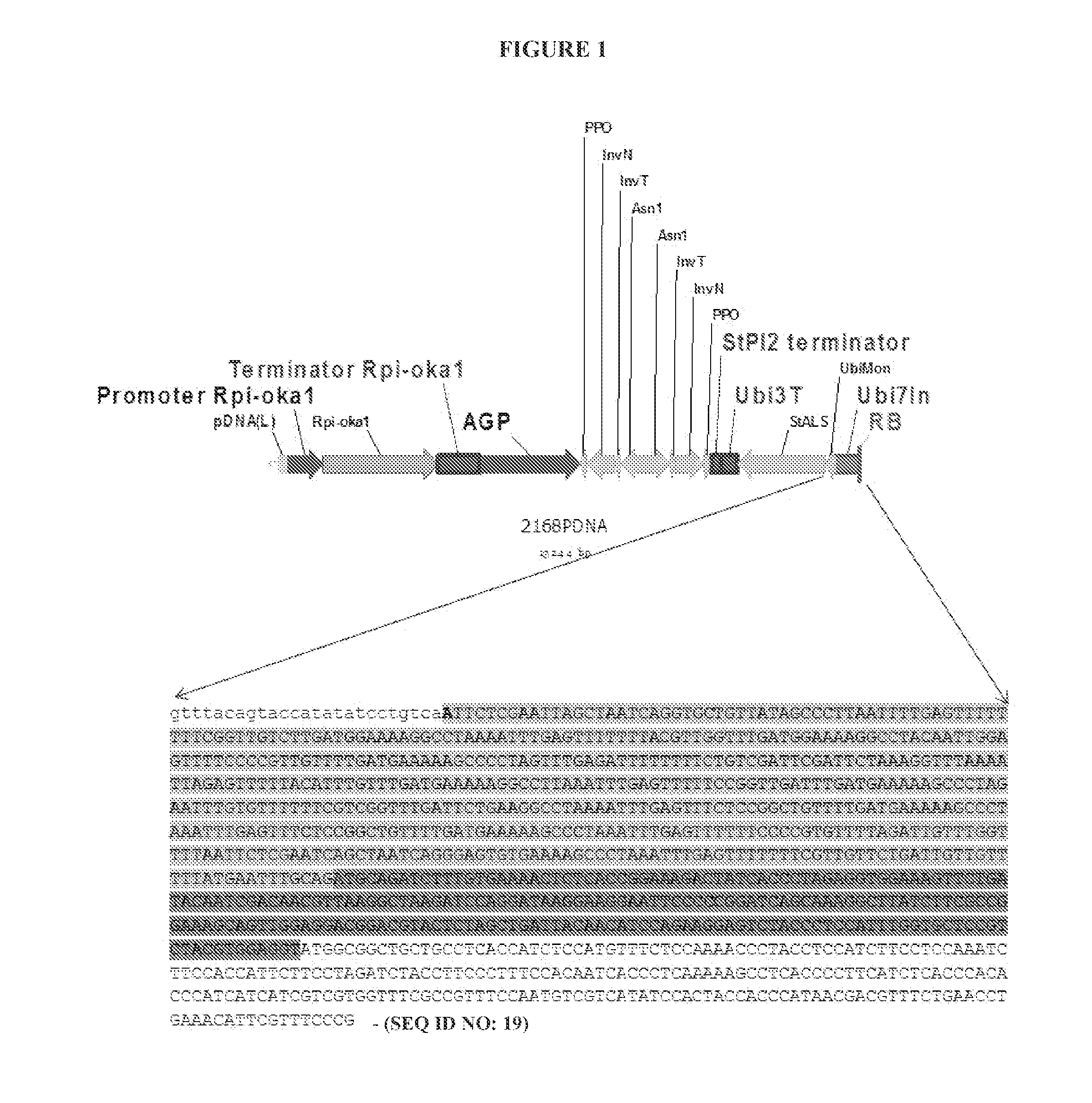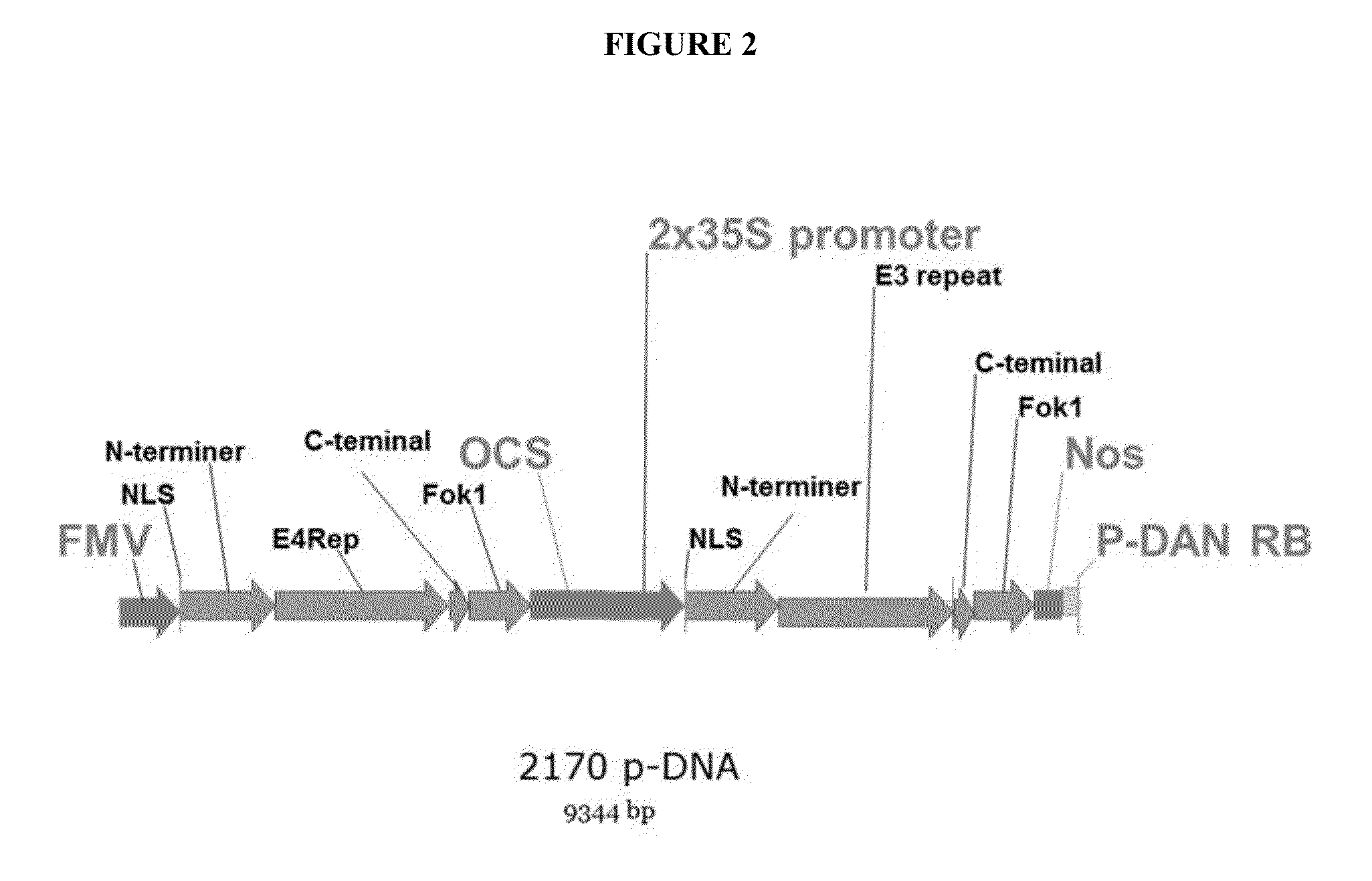Tal-mediated transfer DNA insertion
a technology of transfer dna and insertion site, which is applied in the field of plant biotechnology, can solve the problems of disconcerting challenges associated with the employment of transgenic traits, and achieve the effect of conferring resistance to als inhibiting herbicides and resistance to als inhibitor-type herbicides
- Summary
- Abstract
- Description
- Claims
- Application Information
AI Technical Summary
Benefits of technology
Problems solved by technology
Method used
Image
Examples
example 1
Method for Targeted Insertion
[0111]A preferred target site for gene insertion is within an intron positioned in the untranslated 5′-leader region of the potato's ubiquitin-7 (Ubi7) gene. Potato is tetraploid and contains four copies of this gene; the copies are identical or near-identical. The Ubi7 genes are expressed at high levels in a near-constitutive manner, which suggests that they are located in regions that promote transcriptional activity. Sequences positioned within a transfer DNA are therefore expected to be effectively expressed. Furthermore, insertional inactivation of one of the Ubi7 genes is not expected to cause any quality or agronomic issues because potato still contains three functionally-active copies of the gene.
[0112]DNA segments were inserted into the intron sequence of the ubiquitin-7 gene according to the following steps:
[0113](1) TAL effectors were designed to bind to sequences within the intron, which is (a) more than about 25-bp upstream from the region c...
example 2
Imazamox Kill-Curve Essay
[0123]To determine the concentration of imazamox needed to kill untransformed potato cells, Ranger Russet internode stem explants were transformed with the binary vector pSIM1331. This vector contains (a) an expression cassette for the selectable marker gene nptII inserted between borders and (b) an expression cassette for the ipt gene in the backbone. The strain used to mediate transformation was Agrobacterium strain LBA4404, grown to an OD600 of 0.2. Following a 10 minute inoculation period, the explants were transferred to co-culture medium and placed in a Percival growth chamber at 24° C. under filtered light for 48 hours. Inter-node explants were transferred to hormone-free medium (HFM) containing the antibiotic timentin but lacking imazamox. Petri plates were place in Percival growth chamber at 24° C. and a 16 h photoperiod.
[0124]After two weeks, the inter-node explants were transferred to HFM containing timentin and five treatment concentrations (0, 0...
example 3
Transformation and Regeneration of Potato Plants from Stem Explants Single Strain Approach
[0128](1) 3-4-week old in vitro Ranger Russet potato plants growing on stock medium comprising 2.22 g / l Murashige & Skoog modified basal medium with Gamborg vitamins (M404; PhytoTechnology Laboratories), 15 g / l sucrose (S24060; Research Products International Corp.) and 2.0 g / l Gelzan (G024; Caisson) at pH 5.7, were used.
[0129](2) The leaves and node sections were removed and inter-node stem portions were isolated. The inter-node stem portions were cut into 3-5 mm explants sections and placed in 15 ml of MS liquid medium containing 4.44 g / l Murashige & Skoog modified basal medium with Gamborg vitamins (M404; PhytoTechnology Laboratories), and 30 g / l sucrose (S24060; Research Products International Corp.) at pH 5.7.
[0130](3) Agrobacterium (LBA4404) derived from a single colony containing a binary vector TAL effector cassette and a binary vector gene-of-interest cassette was grown overnight in L...
PUM
| Property | Measurement | Unit |
|---|---|---|
| Electrical resistance | aaaaa | aaaaa |
Abstract
Description
Claims
Application Information
 Login to View More
Login to View More - R&D
- Intellectual Property
- Life Sciences
- Materials
- Tech Scout
- Unparalleled Data Quality
- Higher Quality Content
- 60% Fewer Hallucinations
Browse by: Latest US Patents, China's latest patents, Technical Efficacy Thesaurus, Application Domain, Technology Topic, Popular Technical Reports.
© 2025 PatSnap. All rights reserved.Legal|Privacy policy|Modern Slavery Act Transparency Statement|Sitemap|About US| Contact US: help@patsnap.com



